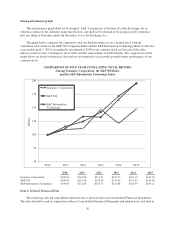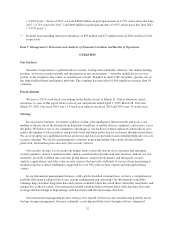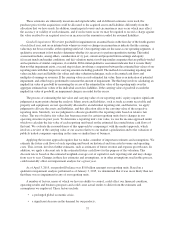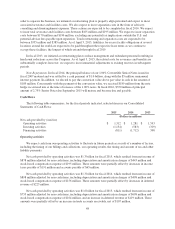Symantec 2015 Annual Report Download - page 116
Download and view the complete annual report
Please find page 116 of the 2015 Symantec annual report below. You can navigate through the pages in the report by either clicking on the pages listed below, or by using the keyword search tool below to find specific information within the annual report.• the inability to develop new and enhanced products and services in a timely manner;
• a significant adverse change in legal factors or in the business climate;
• an adverse action or assessment by a regulator;
• successful efforts by our competitors to gain market share in our markets;
• a loss of key personnel;
• our determination to dispose of one or more of our reporting units;
• the testing for recoverability of a significant asset group within a reporting unit; and
• recognition of a goodwill impairment loss.
Intangible asset impairment. We assess the impairment of identifiable finite-lived intangible assets
whenever events or changes in circumstances indicate that an asset group’s carrying amount may not be
recoverable. Recoverability of certain finite-lived intangible assets, particularly customer relationships and finite-
lived trade names, would be measured by the comparison of the carrying amount of the asset group to which the
assets are assigned to the sum of the undiscounted estimated future cash flows the asset group is expected to
generate. If an asset is considered to be impaired, the amount of such impairment would be measured as the
difference between the carrying amount of the asset and its fair value. Recoverability and impairment of other
finite-lived intangible assets, particularly developed technology and patents, would be measured by the
comparison of the carrying amount of the asset to the sum of undiscounted estimated future product revenues
offset by estimated future costs to dispose of the product to which the asset relates. For indefinite-lived intangible
assets, we review impairment on an annual basis consistent with the timing of the annual evaluation for goodwill.
These assets generally include trade names and trademarks. Similar to goodwill impairment testing, a qualitative
assessment is first made to determine whether it is necessary to perform quantitative testing. This initial
assessment includes consideration of, among other things: (i) past, current and projected future revenues;
(ii) recent trends and market conditions, including discount rates; and (iii) valuation metrics, such as royalty
rates, involving similar companies that are publicly-traded, if available. If this initial qualitative assessment
indicates that it is more likely than not that impairment exists, a second step is taken. This step involves a
comparison between the fair values of the assets and their respective carrying amounts. Any excess of the
carrying amount over the fair value would be recognized as an impairment charge. Our cash flow assumptions
are based on historical and forecasted future revenue, operating costs, and other relevant factors. Assumptions
and estimates about the remaining useful lives of our intangible assets are subjective and are affected by changes
to our business strategies. If management’s estimates of future operating results change, or if there are changes to
other assumptions, the estimate of the fair value of our identifiable intangible assets could change significantly.
Such change could result in impairment charges in future periods, which could have a significant impact on our
operating results and financial condition.
Long-lived assets. We assess long-lived assets for impairment whenever events or changes in circumstances
indicate that the carrying value of the long-lived assets may not be recoverable. Based on the existence of one or
more indicators of impairment, we assess recoverability of long-lived assets based on a projected undiscounted
cash flow method using assumptions determined by management to be commensurate with the risk inherent in
our current business model. If an asset is not recoverable, impairment is measured as the difference between the
carrying amount and its fair value. Our estimates of cash flows require significant judgment based on our
historical and anticipated results and are subject to many factors which could change and cause a material impact
to our operating results or financial condition. We record impairment charges on long-lived assets held for sale
when we determine that the carrying value of the long-lived assets may not be recoverable. In determining fair
value, we obtain and consider market value appraisal information from third parties.
38
























